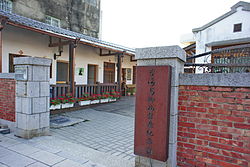| Taiwan Blackfoot Disease Socio-Medical Service Memorial House | |
|---|---|
| 台灣烏腳病醫療紀念館 | |
 | |
| General information | |
| Type | former clinic |
| Location | Beimen, Tainan, Taiwan |
| Coordinates | 23°16′10.4″N 120°07′25.5″E / 23.269556°N 120.123750°E / 23.269556; 120.123750 |
| Opened | September 2007 |
| Management | Wang King-ho Culture and Arts Foundation |
| Website | |
| Official website | |
The Taiwan Blackfoot Disease Socio-Medical Service Memorial House (traditional Chinese: 台灣烏腳病醫療紀念館; simplified Chinese: 台湾乌脚病医疗纪念馆; pinyin: Táiwān Wūjiǎobìng Yīliáo Jìniànguǎn) is a former clinic building in Yonglong Village, Beimen District, Tainan, Taiwan.
History
The memorial house used to be a clinic for Wang King-ho, a doctor who had fought the adverse effects of "blackfoot disease [zh]" (arsenic poisoning) for 25 years by offering free medical services to patients from Beimen and the surrounding regions. Tainan County Magistrate Su Huan-chih and Department of Cultural Affairs Commissioner Ye Tzer-shan then proposed for the reconstruction of the clinic into a memorial house to preserve the history of the disease in Taiwan. Construction began in November 2006 and ended in September 2007. It was then opened by President Chen Shui-bian in end of September of the same year. After inauguration, the memorial house was taken over by the Wang King-ho Culture and Arts Foundation.
See also
References
- "Taiwan Blackfoot Disease Socio-medical Service Memorial House". Southwest Coast National Scenic Area Administration. 19 February 2021. Retrieved 21 June 2021.
- Liu, Wan-jyun; Hetherington, William (8 July 2016). "Cultural awareness, government drive spurring museum growth in Tainan". Taipei Times. Retrieved 1 March 2017.
- "Taiwan Black-foot Disease Socio-Medical Service Memorial House". Taiwan, the Heart of Asia. 26 March 2021. Retrieved 21 June 2021.
- "Introduction". Taiwan Black-foot Disease Socio-Medical Service Memorial House. Retrieved 21 June 2021.
- "Taiwan Black-foot Disease Socio-Medical Service Memorial House". Ministry of Culture, Local Cultural Museum. Archived from the original on 26 September 2017. Retrieved 26 September 2017.
External links
This article about a building or structure in Taiwan is a stub. You can help Misplaced Pages by expanding it. |